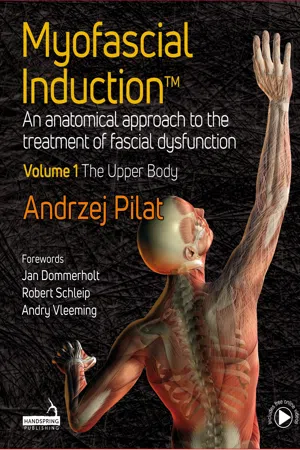![]()
PART 1
The science and principles of Myofascial Induction
CHAPTER 1Introduction: Why this book?
CHAPTER 2Definition and characteristics of fascia and the fascial system
CHAPTER 3Anatomy and functional aspects of fascia
CHAPTER 4Embryological aspects of the fascial system
CHAPTER 5Histological aspects of the fascial system
CHAPTER 6The concept of tensegrity: Fascia as a tensegrity structure
CHAPTER 7Movement and force transmission in the fascial system
CHAPTER 8The neurodynamics of fascia
CHAPTER 9Fascial trauma and dysfunction
CHAPTER 10The assessment process
CHAPTER 11The objectives of Myofascial Induction Therapy
CHAPTER 12Scientific evidence relevant to the MIT approach
![]()
1
Introduction: Why this book?
KEY POINTS
•Outline of the concept of this book
•The conceptual framework for health care
•Definition of the movement system
•Definition of fascia as the body’s communication network
•Importance of fascia’s role in body movement
•The principles of therapeutic touch
•Definition of Myofascial Induction Therapy and its relation to other myofascial approaches
Introduction
The fascial structure constitutes a complex network which links all the systems of the body (Fig. 1.1). In the past 10 years we have witnessed a dizzying increase in research related to fascial tissue. This research is bringing together more and more scientific disciplines, such as biology, physics, biochemistry, and neuroscience. Simultaneously, systemic reasoning is becoming more evident in health care. Clinical trials increasingly support the need to include fascial approaches in treatment protocols.
Before carrying out research on biological structures like the human body we have to study anatomy. Nothing that happens in the body can be “antianatomical.” We always look at the anatomy for confirmation of the clinical diagnosis. Gross anatomy, which is usually performed on embalmed cadavers, allows anatomical structures to be topographically located; however, the interrelation between structures is often distorted or broken.
The opportunity to carry out anatomical dissections of unembalmed cadavers, which have been preserved only at low temperatures, has allowed us to approach the construction of the body from a different perspective – the perspective of continuity and integration (see Chapter 3). This knowledge is reflected in the analysis of body movement at all levels of construction, from microstructures to macrostructures, which brings clinical reasoning closer to the totality of the body’s response to each movement requirement (see Chapters 5 and 6). The presence of unspecialized connective tissue – the connective tissue located between anatomical structures (e.g., between muscle fibers, between fascicles, between muscle epimysia, and between muscles and neurovascular tracts) – that links anatomical components to create an uninterrupted communication network has necessitated a change in movement paradigms (see Chapter 7). We now know that this tissue is richly innervated, has contractile capacity, and actively participates in movement (see Chapter 8).
For example, to drink a cup of coffee we activate 32 muscles controlled by the stimuli of numerous mechanoreceptors, which act with great precision and, in sequences, adjust to interoceptive and exteroceptive information. By grasping the cup, Merkel’s receptors act, recognizing the texture and shape of the cup. The deformation (stretching) of the skin of the hand is detected by Ruffini receptors; Meissner’s corpuscles respond when the fingers slide slightly to improve the grip; and Pacinian corpuscles control the degree of pressure created by holding the cup. The process is carried out with extreme precision which allows the brain to choose the motor units of the muscles involved to perform the task efficiently without excessive expenditure of energy.
Figure 1.1
Continuity of the superficial and deep fascia of the thigh. A Cross-section of the thigh. Note the compartmental structures that create space for the movement of the muscles, bones, and neurovascular tracts. B Anterolateral aspect of the knee and thigh. C Cross-section of a loofah. The fibrous distribution resembles fascial architecture
Van der Wal (2009) states that mechanoreceptors do not understand muscles or ligaments or capsules, but rather the strain of their deformable environment (meaning the fascial tissue). Therefore, the activity and role of a mechanoreceptor is defined not only by its functional properties but also by the architecture of its environment. This means that it is the architecture of the fascial system that encodes the mechanoreceptive information. Therefore, whether an Aδ fiber or a type C fiber encodes nociceptive information or other interoceptive information will depend on the architecture of the tissue environment (see Chapter 8). It should be noted that mechanoreceptors are not exclusively subject to their mechanical environment but also to the experiential environment, expectations, and the experience of other sensory systems such as vision. The scientific discoveries and clinical experiences outlined above have led to the need to review and update our knowledge of the fascial system.
This book brings the reader closer to fascial architecture, which is demonstrated and discussed based on numerous photographs and videos of dissections of unembalmed cadavers. The objective of this book is not only to focus on the topographic anatomy of the fascia, although this is widely illustrated and discussed, but rather to demonstrate the continuity of the fascial system and its dynamic links with the other systems of the body.
These observations invite us to change the existing paradigms related to body movement a...

